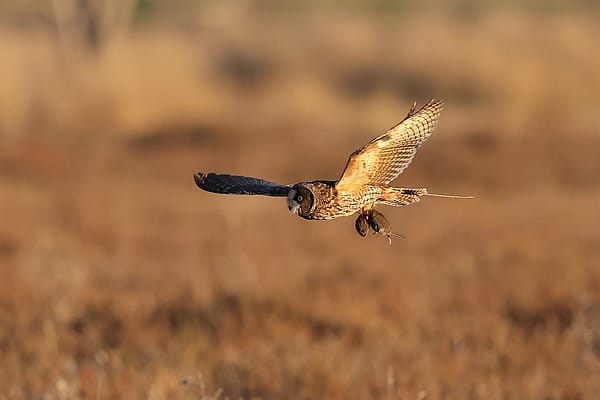
The Amazing Hawks
Hawks are birds of prey that hunt, kill, and dine on other animals. They have powerful feet with curved, sharp talons; a sharp, hooked upper beak; and excellent eyesight to help them hunt. In this blog I will discuss 13 interesting facts about a number of hawks. Although Harriers are considered hawks by some, but not by others, I have included them in this blog.
1) Northern Harriers mainly prey on small mammals and birds. Relying on both hearing and sight, they may be seen flying low over fields in search of prey. They may also chase prey on foot. Occasionally Harriers take larger prey such as rabbits and ducks. Harriers sometimes kill this larger prey by drowning them in water such as irrigation ditches.
2) According to Cornell Lab’s All About Birds web page, male Northern Harriers can be quite polygamous. Although one or two mates are typical, the male may have up to five at one time. No matter how many ladies he takes up with, he will provide food for all his mates and their offspring.
3) Young and old Swainson’s Hawks begin gathering together in the fall as they are getting ready to migrate. These flocks can reach up to 10,000 birds!
4) Swainson’s Hawks love snakes, small rodents, and insects such as grasshoppers, crickets, and beetles. During grasshopper season they may eat 100 a day.
5) It is probably that no more than about 50 pairs of Gray Hawks nest north of Mexico. Gray Hawks can fly rapidly among tree limbs and dense brush. With quick descending attacks, this hawk uses its talons to pick fast-running lizards or birds from branches.

6) Along with Gray Hawks, the Northern Goshawks, Cooper’s Hawks, and Sharp-shinned Hawks navigate through the forests at top speed in pursuit of prey.
Check out this video to see how a Goshawk can maneuver through the forest: https://www.youtube.com/watch?v=2CFckjfP-1E
7) Northern Goshawks may have up to eight nests within their territory. Since they will finally settle on one nest for the season, it can be a challenge for researchers trying to set up for observing the bird during nesting season.
8) Being a soft-hearted person, I found this fact rather disturbing but still very interesting. Cooper’s hawks capture their prey with their talons, then kill it by holding it away from their body and repeatedly squeezing it to death. They have also been observed drowning prey by holding it under water.

9) Male and female Red-shouldered Hawks build or refurbish nests together, sometimes right on top of another bird’s, or even on a squirrel’s, nest.
10) Zone-tailed Hawks often imitate the soaring flight of turkey vultures and at times will even join them in flight. Some researchers believe flying with the non-threatening vultures allows them to approach prey below with out alarming them. Other researchers, however, think that gliding on the thermals is simply an energy efficient way of moving from place to place. I like the Turkey Vulture theory best, how about you?

11) Harris Hawks are sometimes compared to a pack of wolves. With cooperative hunting methods, they work together in families and unrelated groups to flush, chase, and ambush prey. They will then share the kill, usually in the order of social rank. Adults, however, will usually allow juveniles to eat first.
12) Like most raptors during nesting season, male sharp-shinned hawks will do the hunting while the female incubates the eggs and takes care of the hatchlings. Before bringing prey to its mate or young, a male sharp-shinned hawk will typically tear off the head and eat it.

13) Red-tailed hawks eat a variety of prey, but you may be surprised to learn that the remains of rattlesnakes regularly show up in red-tailed hawks nests. The red-tail has developed a method for killing this dangerous prey. Landing near the snake, the red-tail will open both wings, then sometimes flutter one or both, or sweep one forward. This movement will draw the snake’s attention to the wings and if it makes a strike, the snake will most likely get a mouthful of feathers. According to Dr. Charles Preston’s book, Red-tailed Hawk, the hawk typically uses it’s talons to grab the snake in the middle of its body, then makes a quick bite to the head.
Check out this National Geographic Wild video of a red-tailed hawk and a rattlesnake: http://www.youtube.com/watch?v=_3h8x67I1iw
Photo Credits:
Northern Harrier by Andrew Reding, Attribution-NonCommercial-NoDerivs 2.0 Generic license
Swainson’s Haw by sfitzgerald86, NonCommercial Attribution License
Northern Goshawk by by Martha de Jong-Lantink, Attribution-NonCommercial-NoDerivs 2.0 Generic Deed
Red-shouldered Hawk by Andy Reago & Chrissy McClarren, Attribution 2.0 Generic license
Zone-tailed Hawk by sfitzgerald86, Attribution-NonCommercial 2.0 Generic license
Harris Hawk by Doug Greenbert , Attribution-NonCommercial 2.0 Generic Deed
Isham, the red-tailed hawk photo from the Draper Museum Raptor Experience
Written By
Anne Hay
Anne Hay has a Bachelor's degree in Elementary Education and a Master's in Computers in Education. She spent most of her working years teaching third grade at Livingston School in Cody, Wyoming. After retiring she began doing a variety of volunteer work for the Buffalo Bill Center of the West’s Draper Natural History Museum. Anne loves nature and has a concern for the environment. She believes that educating the public, so that they will have a better understanding and appreciation for the natural world, is very important. Because of this belief, volunteering at the Center is a perfect fit. She spends time in the Draper Lab, observing eagle nests for Dr. Charles Preston’s long-term research project on nesting golden eagles, writing observation reports of raptor sightings in the Bighorn Basin, and working with the Draper Museum Raptor Experience. Anne states that, “Having a bird on my glove, is one of my all time favorite things in life.”

















